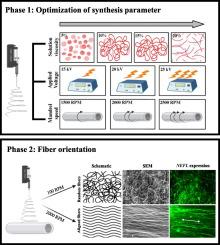Influence of electrospinning parameters on polycaprolactone fiber alignment for the differentiation of embryonic stem cells into neuronal lineage – A systematic study
IF 6
2区 医学
Q2 MATERIALS SCIENCE, BIOMATERIALS
Materials Science & Engineering C-Materials for Biological Applications
Pub Date : 2025-09-05
DOI:10.1016/j.bioadv.2025.214485
引用次数: 0
Abstract
Electrospun fiber alignment plays a significant role in the proliferation and differentiation of embryonic stem cells (ESCs) into mature neurons. Although previous studies have reported the impact of aligned fibers on increasing neurite outgrowth, there is still a knowledge gap in the influence of synthesis parameters on fiber formation, alignment, and stem cell differentiation. To bridge this gap, we aimed to utilize polycaprolactone (PCL) electrospun fibers as a scaffold model to test synthesis parameters to facilitate the differentiation of ESCs into mature neurons with aligned neurites. This study is divided into two distinct phases. Phase 1 focuses on optimizing the synthesis parameters, including solution viscosity, applied voltage, and the rotational speed of the mandrel to produce aligned fibers. Phase 2 investigates the physicochemical properties of these aligned fibers in comparison to PCL random fibers and two-dimensional (2D) flat membranes. Our results demonstrated that the fiber group exhibited enhanced hydrophilicity, greater resistance to degradation, and superior tensile strength when compared to the 2D flat membranes. Immunocytochemistry analysis of neural markers, including Nestin, Sox2, GFAP, and NEFL, revealed that both aligned and random fiber groups showed higher expression levels of these markers compared to the flat membrane group. Notably, the aligned fiber group displayed NEFL expressions along the axis of the fibers, in contrast to the random fibers, suggesting the importance of fiber alignment in supporting aligned nerve regeneration. The outcomes of phase 1 address the critical factors and key areas that must be considered when developing an electrospun fiber-based scaffold, where phase 2 provides valuable insights into how the geometry and topography of electrospun fibrous scaffolds influence the mechanotransduction of stem cells during differentiation into mature neurons. This systematic analysis of PCL based electrospun fibers, starting from parameter optimisation towards physicochemical characterization, followed by biological validation for nerve regeneration, fills the gap in existing literature.

静电纺丝参数对胚胎干细胞向神经元谱系分化过程中聚己内酯纤维排列影响的系统研究
电纺丝纤维定向在胚胎干细胞向成熟神经元的增殖和分化过程中起着重要作用。虽然先前的研究报道了排列纤维对增加神经突生长的影响,但在合成参数对纤维形成、排列和干细胞分化的影响方面仍然存在知识空白。为了弥补这一空白,我们旨在利用聚己内酯(PCL)电纺丝纤维作为支架模型来测试合成参数,以促进ESCs向具有排列神经突的成熟神经元的分化。本研究分为两个不同的阶段。第一阶段的重点是优化合成参数,包括溶液粘度、施加电压和芯棒的转速,以产生排列的纤维。第二阶段研究了这些排列纤维的物理化学性质,并与PCL随机纤维和二维平面膜进行了比较。我们的研究结果表明,与二维平面膜相比,纤维组表现出增强的亲水性,更强的抗降解性和优越的拉伸强度。免疫细胞化学分析神经标记物,包括Nestin、Sox2、GFAP和NEFL,显示与平膜组相比,排列和随机纤维组的这些标记物的表达水平更高。值得注意的是,与随机纤维相比,排列纤维组沿纤维轴显示NEFL表达,这表明纤维排列在支持排列神经再生中的重要性。第一阶段的结果解决了在开发基于电纺丝纤维的支架时必须考虑的关键因素和关键领域,第二阶段的结果提供了有价值的见解,了解了电纺丝纤维支架的几何形状和地形如何影响干细胞向成熟神经元分化过程中的机械转导。从参数优化到物理化学表征,再到神经再生的生物学验证,对PCL基电纺丝纤维进行了系统的分析,填补了现有文献的空白。
本文章由计算机程序翻译,如有差异,请以英文原文为准。
求助全文
约1分钟内获得全文
求助全文
来源期刊
CiteScore
17.80
自引率
0.00%
发文量
501
审稿时长
27 days
期刊介绍:
Biomaterials Advances, previously known as Materials Science and Engineering: C-Materials for Biological Applications (P-ISSN: 0928-4931, E-ISSN: 1873-0191). Includes topics at the interface of the biomedical sciences and materials engineering. These topics include:
• Bioinspired and biomimetic materials for medical applications
• Materials of biological origin for medical applications
• Materials for "active" medical applications
• Self-assembling and self-healing materials for medical applications
• "Smart" (i.e., stimulus-response) materials for medical applications
• Ceramic, metallic, polymeric, and composite materials for medical applications
• Materials for in vivo sensing
• Materials for in vivo imaging
• Materials for delivery of pharmacologic agents and vaccines
• Novel approaches for characterizing and modeling materials for medical applications
Manuscripts on biological topics without a materials science component, or manuscripts on materials science without biological applications, will not be considered for publication in Materials Science and Engineering C. New submissions are first assessed for language, scope and originality (plagiarism check) and can be desk rejected before review if they need English language improvements, are out of scope or present excessive duplication with published sources.
Biomaterials Advances sits within Elsevier''s biomaterials science portfolio alongside Biomaterials, Materials Today Bio and Biomaterials and Biosystems. As part of the broader Materials Today family, Biomaterials Advances offers authors rigorous peer review, rapid decisions, and high visibility. We look forward to receiving your submissions!

 求助内容:
求助内容: 应助结果提醒方式:
应助结果提醒方式:


